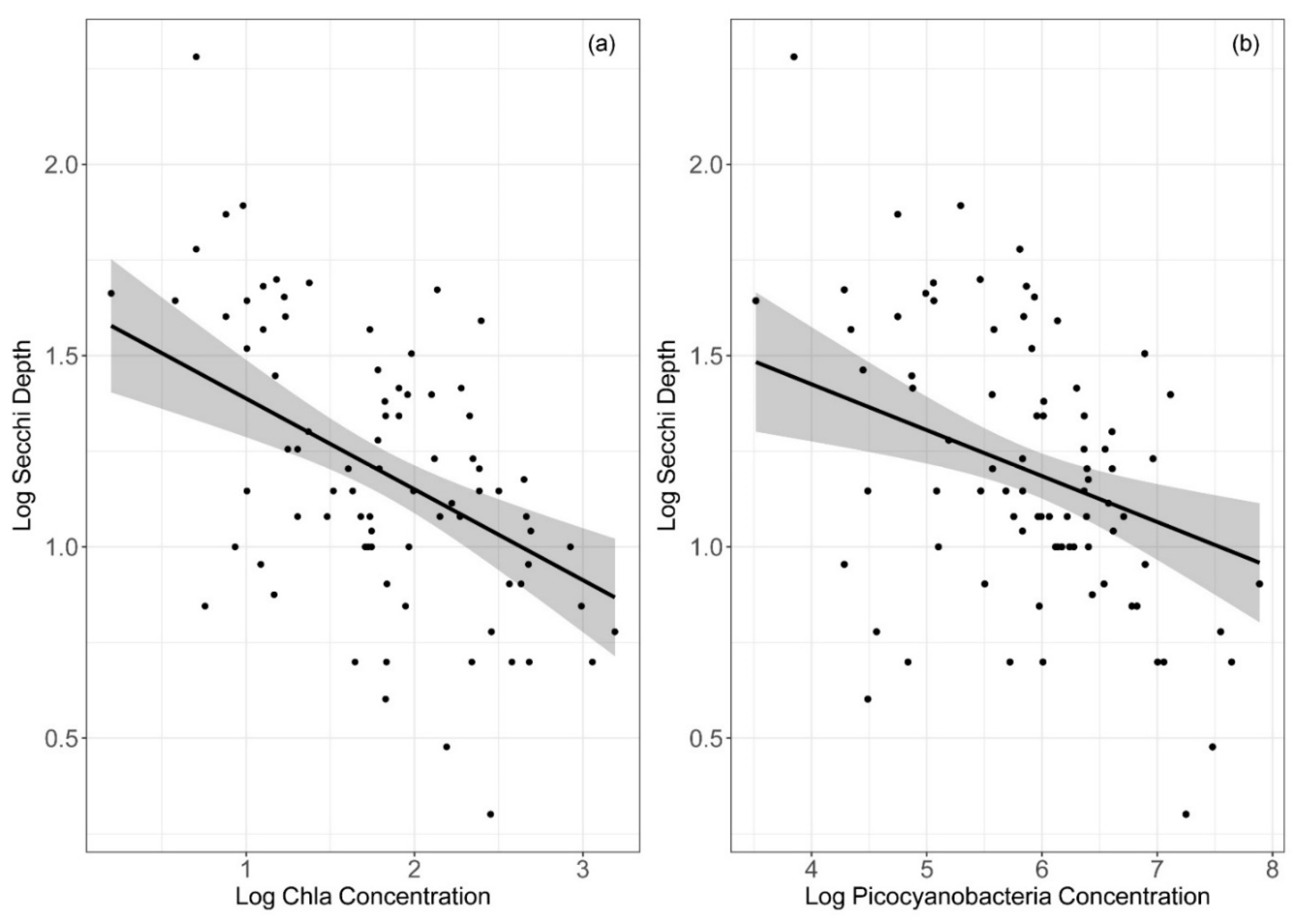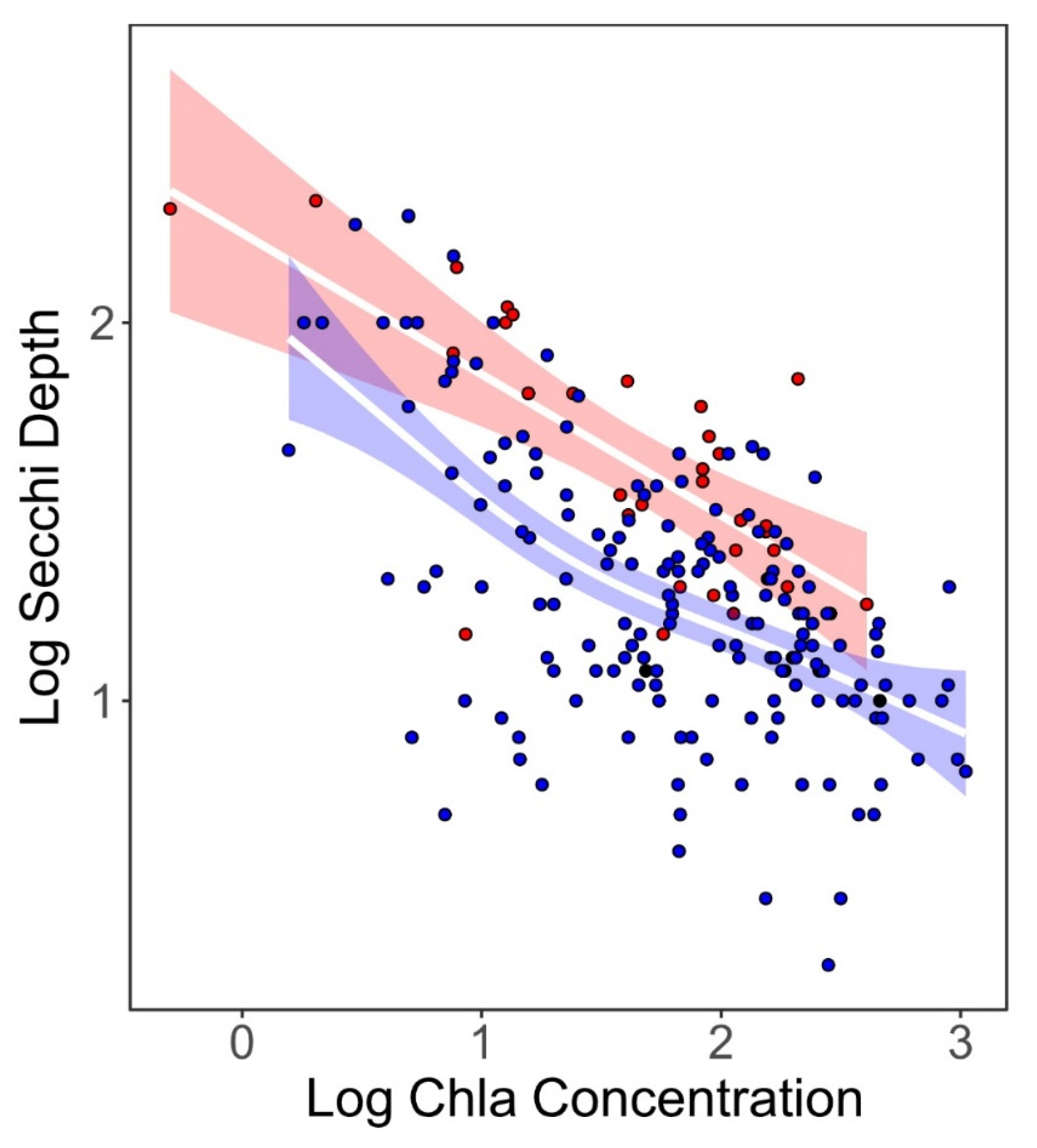Increases in Picocyanobacteria Abundance in Agriculturally Eutrophic Pampean Lakes Inferred from Historical Records of Secchi Depth and Chlorophyll-a
Abstract
:1. Introduction
2. Materials and Methods
3. Results
4. Discussion
5. Conclusions
Author Contributions
Funding
Institutional Review Board Statement
Informed Consent Statement
Data Availability Statement
Acknowledgments
Conflicts of Interest
References
- Marañón, E. Cell Size as a Key Determinant of Phytoplankton Metabolism and Community Structure. Annu. Rev. Mar. Sci. 2015, 7, 241–264. [Google Scholar] [CrossRef] [PubMed] [Green Version]
- Azam, F.; Fenchel, T.; Field, J.G.; Gray, J.S.; Meyer-Reil, L.A.; Thingstad, F. The Ecological Role of Water-Column Microbes in the Sea. Mar. Ecol. Prog. Ser. 1983, 10, 257. [Google Scholar] [CrossRef]
- Legendre, L.; LeFevre, J. Microbial Food Webs and the Export of Biogenic Carbon in Oceans. Aquat. Microb. Ecol. 1995, 09, 69–77. [Google Scholar] [CrossRef] [Green Version]
- Sarmento, H. New Paradigms in Tropical Limnology: The Importance of the Microbial Food Web. Hydrobiologia 2012, 686, 1–14. [Google Scholar] [CrossRef]
- Smith, V.H.; Joye, S.B.; Howarth, R.W. Eutrophication of Freshwater and Marine Ecosystems. Limnol. Oceanogr. 2006, 51, 351–355. [Google Scholar] [CrossRef] [Green Version]
- Diovisalvi, N.; Bohn, V.Y.; Piccolo, M.C.; Perillo, G.M.E.; Baigún, C.; Zagarese, H.E. Shallow Lakes from the Central Plains of Argentina: An Overview and Worldwide Comparative Analysis of Their Basic Limnological Features. Hydrobiologia 2015, 752, 5–20. [Google Scholar] [CrossRef]
- Castro Berman, M.; Marino, D.J.G.; Quiroga, M.V.; Zagarese, H. Occurrence and Levels of Glyphosate and AMPA in Shallow Lakes from the Pampean and Patagonian Regions of Argentina. Chemosphere 2018, 200, 513–522. [Google Scholar] [CrossRef]
- Rennella, A.M.; Quirós, R. The Effects of Hydrology on Plankton Biomass in Shallow Lakes of the Pampa Plain. Hydrobiologia 2006, 556, 181–191. [Google Scholar] [CrossRef]
- Zagarese, H.E.; González Sagrario, M.Á.; Wolf-Gladrow, D.; Nõges, P.; Nõges, T.; Kangur, K.; Matsuzaki, S.-I.S.; Kohzu, A.; Vanni, M.J.; Özkundakci, D.; et al. Patterns of CO2 Concentration and Inorganic Carbon Limitation of Phytoplankton Biomass in Agriculturally Eutrophic Lakes. Water Res. 2021, 190, 116715. [Google Scholar] [CrossRef]
- Izaguirre, I.; Zagarese, H.E.; O’Farrell, I. The Limnological Trace of Contemporaneous Anthropogenic Activities in the Pampa Region. Ecol. Austral. 2022, submitted.
- Duke, S.O. The History and Current Status of Glyphosate. Pest. Manag. Sci. 2018, 74, 1027–1034. [Google Scholar] [CrossRef]
- Binimelis, R.; Pengue, W.; Monterroso, I. “Transgenic Treadmill”: Responses to the Emergence and Spread of Glyphosate-Resistant Johnsongrass in Argentina. Geoforum 2009, 40, 623–633. [Google Scholar] [CrossRef]
- Forlani, G.; Pavan, M.; Gramek, M.; Kafarski, P.; Lipok, J. Biochemical Bases for a Widespread Tolerance of Cyanobacteria to the Phosphonate Herbicide Glyphosate. Plant Cell Physiol. 2008, 49, 443–456. [Google Scholar] [CrossRef] [PubMed]
- Saxton, M.A.; Morrow, E.A.; Bourbonniere, R.A.; Wilhelm, S.W. Glyphosate Influence on Phytoplankton Community Structure in Lake Erie. J. Great Lakes Res. 2011, 37, 683–690. [Google Scholar] [CrossRef]
- Lipok, J.; Studnik, H.; Gruyaert, S. The Toxicity of Roundup® 360 SL Formulation and Its Main Constituents: Glyphosate and Isopropylamine towards Non-Target Water Photoautotrophs. Ecotox. Environ. Safe 2010, 73, 1681–1688. [Google Scholar] [CrossRef]
- Pérez, G.L.; Torremorell, A.; Mugni, H.; Rodríguez, P.; Vera, M.S.; do Nascimento, M.; Allende, L.; Bustingorry, J.; Escaray, R.; Ferraro, M.; et al. Effects of the Herbicide Roundup on Freshwater Microbial Communities: A Mesocosm Study. Ecol. Appl. 2007, 17, 2310–2322. [Google Scholar] [CrossRef] [Green Version]
- Vera, M.S.; Lagomarsino, L.; Sylvester, M.; Pérez, G.L.; Rodríguez, P.; Mugni, H.; Sinistro, R.; Ferraro, M.; Bonetto, C.; Zagarese, H.; et al. New Evidences of Roundup (Glyphosate Formulation) Impact on the Periphyton Community and the Water Quality of Freshwater Ecosystems. Ecotoxicol. Lond. Engl 2010, 19, 710–721. [Google Scholar] [CrossRef]
- Vera, M.S.; Fiori, E.D.; Lagomarsino, L.; Sinistro, R.; Escaray, R.; Iummato, M.M.; Juárez, A.; Ríos de Molina, M.d.C.; Tell, G.; Pizarro, H. Direct and Indirect Effects of the Glyphosate Formulation Glifosato Atanor® on Freshwater Microbial Communities. Ecotoxicol. Lond. Engl. 2012, 21, 1805–1816. [Google Scholar] [CrossRef]
- Castro Berman, M.; Llames, M.E.; Minotti, P.; Fermani, P.; Quiroga, M.V.; Ferraro, M.A.; Metz, S.; Zagarese, H.E. Field Evidence Supports Former Experimental Claims on the Stimulatory Effect of Glyphosate on Picocyanobacteria Communities. Sci. Total Environ. 2020, 701, 134601. [Google Scholar] [CrossRef] [PubMed]
- Ilikchyan, I.N.; McKay, R.M.L.; Zehr, J.P.; Dyhrman, S.T.; Bullerjahn, G.S. Detection and Expression of the Phosphonate Transporter Gene PhnD in Marine and Freshwater Picocyanobacteria. Environ. Microbiol. 2009, 11, 1314–1324. [Google Scholar] [CrossRef]
- Kutovaya, O.A.; McKay, R.M.L.; Bullerjahn, G.S. Detection and Expression of Genes for Phosphorus Metabolism in Picocyanobacteria from the Laurentian Great Lakes. J. Great Lakes Res. 2013, 39, 612–621. [Google Scholar] [CrossRef]
- Fermani, P.; Diovisalvi, N.; Torremorell, A.; Lagomarsino, L.; Zagarese, H.E.; Unrein, F. The Microbial Food Web Structure of a Hypertrophic Warm-Temperate Shallow Lake, as Affected by Contrasting Zooplankton Assemblages. Hydrobiologia 2013, 714, 115–130. [Google Scholar] [CrossRef]
- Fermani, P.; Torremorell, A.; Lagomarsino, L.; Escaray, R.; Unrein, F.; Pérez, G. Microbial Abundance Patterns along a Transparency Gradient Suggest a Weak Coupling between Heterotrophic Bacteria and Flagellates in Eutrophic Shallow Pampean Lakes. Hydrobiologia 2015, 752, 103–123. [Google Scholar] [CrossRef]
- Daley, R.J.; Hobbie, J.E. Direct Counts of Aquatic Bacteria by a Modified Epifluorescence Technique. Limnol. Oceanogr. 1975, 20, 875–882. [Google Scholar] [CrossRef]
- Olson, R.J.; Vaulot, D.; Chisholm, S.W. Marine Phytoplankton Distributions Measured Using Shipboard Flow Cytometry. Deep Sea Res. Part Oceanogr. Res. Pap. 1985, 32, 1273–1280. [Google Scholar] [CrossRef]
- Bachmann, R.W.; Hoyer, M.V.; Croteau, A.C.; Canfield, D.E. Factors Related to Secchi Depths and Their Stability over Time as Determined from a Probability Sample of US Lakes. Environ. Monit. Assess. 2017, 189, 206. [Google Scholar] [CrossRef] [PubMed]
- Carlson, R.E. A Trophic State Index for Lakes. Limnol. Oceanogr. 1977, 22, 361–369. [Google Scholar] [CrossRef] [Green Version]
- Brezonik, P.L.; Bouchard, R.W.; Finlay, J.C.; Griffin, C.G.; Olmanson, L.G.; Anderson, J.P.; Arnold, W.A.; Hozalski, R. Color, Chlorophyll a, and Suspended Solids Effects on Secchi Depth in Lakes: Implications for Trophic State Assessment. Ecol. Appl. 2019, 29, e01871. [Google Scholar] [CrossRef]
- Kirk, J. Light and Photosynthesis in Aquatic Ecosystems; Cambridge University Press: Cambridge, UK, 1983. [Google Scholar] [CrossRef]
- Stramski, D.; Kiefer, D.A. Light Scattering by Microorganisms in the Open Ocean. Prog. Oceanogr. 1991, 28, 343–383. [Google Scholar] [CrossRef]
- Gallegos, C.L.; Werdell, P.J.; McClain, C.R. Long-term Changes in Light Scattering in Chesapeake Bay Inferred from Secchi Depth, Light Attenuation, and Remote Sensing Measurements. J. Geophys. Res. Ocean. 2011, 116, C00H08. [Google Scholar] [CrossRef]
- Mazumder, A.; Taylor, W.D.; McQueen, D.J.; Lean, D.R.S. Effects of Fish and Plankton on Lake Temperature and Mixing Depth. Science 1990, 247, 312–315. [Google Scholar] [CrossRef]
- Havens, K.E.; Heath, R.T. Increased Transparency Due to Changes in the Algal Size Spectrum during Experimental Acidification in Mesocosms. J. Plankton Res. 1991, 13, 673–679. [Google Scholar] [CrossRef]
- Pérez, G.L.; Lagomarsino, L.; Zagarese, H.E. Optical Properties of Highly Turbid Shallow Lakes with Contrasting Turbidity Origins: The Ecological and Water Management Implications. J. Environ. Manag. 2013, 130, 207–220. [Google Scholar] [CrossRef]
- Wood, N. Generalized Additive Models: An Introduction with R; Chapman and Hall/CRC: Boca Raton, FL, USA, 2017. [Google Scholar]
- Wood, S.N.; Pya, N.; Säfken, B. Smoothing Parameter and Model Selection for General Smooth Models. J. Am. Stat. Assoc. 2016, 111, 1548–1563. [Google Scholar] [CrossRef]
- Simpson, G. Gratia: Graceful Ggplot-Based Graphics and Other Useful Functions for Gams Fitted Using Mgcv. 2018. Available online: https://cran.r-project.org/web/packages/gratia/index.html (accessed on 29 December 2021).
- Wickham, H. Ggplot2: Elegant Graphics for Data Analysis; Springer: New York, NY, USA, 2016; ISBN 978-3-319-24277-4. [Google Scholar]
- R Core Team. R: A Language and Environment for Statistical Computing; R Foundation for Statistical Computing: Vienna, Austria, 2018. [Google Scholar]
- Pedersen, E.J.; Miller, D.L.; Simpson, G.L.; Ross, N. Hierarchical Generalized Additive Models in Ecology: An Introduction with Mgcv. PeerJ 2019, 7, e6876. [Google Scholar] [CrossRef] [PubMed] [Green Version]
- Burnham, K.P.; Anderson, D.R. Model Selection and Inference, A Practical Information-Theoretic Approach; Springer: New York, NY, USA, 1998; ISBN 9781475729191. [Google Scholar]
- Pérez, G.L.; Torremorell, A.; Bustingorry, J.; Escaray, R.; Pérez, P.; Diéguez, M.; Zagarese, H. Optical Characteristics of Shallow Lakes from the Pampa and Patagonia Regions of Argentina. Limnol. Ecol Manag. Inland Waters 2010, 40, 30–39. [Google Scholar] [CrossRef] [Green Version]
- Testa, J.M.; Lyubchich, V.; Zhang, Q. Patterns and Trends in Secchi Disk Depth over Three Decades in the Chesapeake Bay Estuarine Complex. Estuaries Coasts 2019, 42, 927–943. [Google Scholar] [CrossRef]
- Quiroga, M.V.; Huber, P.; Ospina-Serna, J.; Diovisalvi, N.; Odriozola, M.; Cueto, G.R.; Lagomarsino, L.; Fermani, P.; Bustingorry, J.; Escaray, R.; et al. The Dynamics of Picocyanobacteria from a Hypereutrophic Shallow Lake Is Affected by Light-Climate and Small-Bodied Zooplankton: A Ten-Year Cytometric Time-Series Analysis. FEMS Microbiol. Ecol. 2021, 97, fiab055. [Google Scholar] [CrossRef]
- Ospina-Serna, J.; Huber, P.; Odriozola, M.; Fermani, P.; Unrein, F. Picocyanobacteria Aggregation as a Response of Predation Pressure: The Direct Contact Is Not Necessary. FEMS Microbiol. Ecol. 2020, 96, fiaa153. [Google Scholar] [CrossRef]
- Huber, P.; Diovisalvi, N.; Ferraro, M.; Metz, S.; Lagomarsino, L.; Llames, M.E.; Royo-Llonch, M.; Bustingorry, J.; Escaray, R.; Acinas, S.G.; et al. Phenotypic Plasticity in Freshwater Picocyanobacteria. Environ. Microbiol. 2017, 19, 1120–1133. [Google Scholar] [CrossRef]
- Izaguirre, I.; Vinocur, A. Typology of Shallow Lakes of the Salado River Basin (Argentina), Based on Phytoplankton Communities. Hydrobiologia 1994, 277, 49–62. [Google Scholar] [CrossRef]
- Allende, L.; Tell, G.; Zagarese, H.; Torremorell, A.; Pérez, G.; Bustingorry, J.; Escaray, R.; Izaguirre, I. Phytoplankton and Primary Production in Clear-Vegetated, Inorganic-Turbid, and Algal-Turbid Shallow Lakes from the Pampa Plain (Argentina). Hydrobiologia 2009, 624, 45–60. [Google Scholar] [CrossRef]
- Castro Berman, M.; Farrell, I.O.; Huber, P.; Marino, D.; Zagarese, H. A Large-Scale Geographical Coverage Survey Reveals a Pervasive Impact of Agricultural Practices on Plankton Primary Producers. Agric. Ecosyst. Environ. 2022, 325, 107740. [Google Scholar] [CrossRef]
- Silvoso, J.; Izaguirre, I.; Allende, L. Picoplankton Structure in Clear and Turbid Eutrophic Shallow Lakes: A Seasonal Study. Limnol. Ecol. Manag. Inland Waters 2011, 41, 181–190. [Google Scholar] [CrossRef] [Green Version]
- Huber, P.; Cornejo-Castillo, F.M.; Ferrera, I.; Sánchez, P.; Logares, R.; Metz, S.; Balagué, V.; Acinas, S.G.; Gasol, J.M.; Unrein, F. Primer Design for an Accurate View of Picocyanobacterial Community Structure by Using High-Throughput Sequencing. Appl. Environ. Microb. 2019, 85, e02659-18. [Google Scholar] [CrossRef] [PubMed] [Green Version]
- Hartwell, S.I. Chesapeake Bay Watershed Pesticide Use Declines but Toxicity Increases. Environ. Toxicol. Chem. 2011, 30, 1223–1231. [Google Scholar] [CrossRef]
- Harding, L.W.; Mallonee, M.E.; Perry, E.S.; Miller, W.D.; Adolf, J.E.; Gallegos, C.L.; Paerl, H.W. Long-Term Trends, Current Status, and Transitions of Water Quality in Chesapeake Bay. Sci. Rep. 2019, 9, 6709. [Google Scholar] [CrossRef] [PubMed]
- Wang, K.; Wommack, K.E.; Chen, F. Abundance and Distribution of Synechococcus Spp. and Cyanophages in the Chesapeake Bay. Appl. Environ. Microb. 2011, 77, 7459–7468. [Google Scholar] [CrossRef] [Green Version]
- Burns, N.M.; Rockwell, D.C.; Bertram, P.E.; Dolan, D.M.; Ciborowski, J.J.H. Trends in Temperature, Secchi Depth, and Dissolved Oxygen Depletion Rates in the Central Basin of Lake Erie, 1983–2002. J. Great Lakes Res. 2005, 31, 35–49. [Google Scholar] [CrossRef]
- Barbiero, R.P.; Tuchman, M.L. Long-Term Dreissenid Impacts on Water Clarity in Lake Erie. J. Great Lakes Res. 2004, 30, 557–565. [Google Scholar] [CrossRef]
- Binding, C.E.; Jerome, J.H.; Bukata, R.P.; Booty, W.G. Trends in Water Clarity of the Lower Great Lakes from Remotely Sensed Aquatic Color. J. Great Lakes Res. 2007, 33, 828–841. [Google Scholar] [CrossRef] [Green Version]
- Steffen, M.M.; Belisle, B.S.; Watson, S.B.; Boyer, G.L.; Wilhelm, S.W. Status, Causes and Controls of Cyanobacterial Blooms in Lake Erie. J. Great Lakes Res. 2014, 40, 215–225. [Google Scholar] [CrossRef]
- Torremorell, A.; Llames, M.E.; Pérez, G.L.; Escaray, R.; Bustingorry, J.; Zagarese, H. Annual Patterns of Phytoplankton Density and Primary Production in a Large, Shallow Lake: The Central Role of Light. Freshw. Biol. 2009, 54, 437–449. [Google Scholar] [CrossRef]
- Llames, M.E.; Lagomarsino, L.; Diovisalvi, N.; Fermani, P.; Torremorell, A.M.; Perez, G.; Unrein, F.; Bustingorry, J.; Escaray, R.; Ferraro, M.; et al. The Effects of Light Availability in Shallow, Turbid Waters: A Mesocosm Study. J. Plankton Res. 2009, 31, 1517–1529. [Google Scholar] [CrossRef] [Green Version]
- Wassmann, P. Cultural Eutrophication: Perspectives and Prospects. In Drainage Basin Nutrient Inputs and Eutrophication: An Integrated Approach; Wassmann, P., Olli, K., Eds.; University of Tromsø: Tromsø, Norway, 2004. [Google Scholar]
- Moal, M.L.; Gascuel-Odoux, C.; Ménesguen, A.; Souchon, Y.; Étrillard, C.; Levain, A.; Moatar, F.; Pannard, A.; Souchu, P.; Lefebvre, A.; et al. Eutrophication: A New Wine in an Old Bottle? Sci. Total Environ. 2019, 651, 1–11. [Google Scholar] [CrossRef] [PubMed] [Green Version]
- Moss, B. Ecology of Freshwaters: A View for the Twenty-First Century, 4th ed.; Blackwell Scientific Publication: Hoboken, NJ, USA, 2010; ISBN 978-1-4051-1332-8. [Google Scholar]
- Schulhof, M.A.; Shurin, J.B.; Declerck, S.A.J.; de Waal, D.B.V. Phytoplankton Growth and Stoichiometric Responses to Warming, Nutrient Addition and Grazing Depend on Lake Productivity and Cell Size. Glob. Change Biol. 2019, 25, 2751–2762. [Google Scholar] [CrossRef] [PubMed] [Green Version]
- Del Giorgio, P.A.; Peters, R.H. Balance between Phytoplankton Production and Plankton Respiration in Lakes. Can. J. Fish Aquat. Sci. 1993, 50, 282–289. [Google Scholar] [CrossRef]
- González Sagrario, M.A.; Musazzi, S.; Córdoba, F.; Mendiolar, M.; Lami, A. Inferring the Occurrence of Regime Shifts in a Shallow Lake during the Last 250 Years Based on Multiple Indicators. Ecol. Indic. 2020, 117, 106536. [Google Scholar] [CrossRef]


| Limnological Parameter | Median | Range |
|---|---|---|
| ZSD (cm) | 14 | 2–191 |
| Chla (µg L−1) | 64.28 | 1.58–1549.79 |
| Pcy (cells mL−1) | 9.60 × 105 | 3.3 × 103–7.72 × 107 |
| Total phosphorus (µg L−1) | 620 | 124.2–4538 |
| Total nitrogen (µg L−1) | 5051 | 1702–12,846 |
| pH | 8.9 | 8–10.2 |
| Model | edf | p-Value | Deviance | AIC | DeltaAIC |
|---|---|---|---|---|---|
| Secchi ~ Pcy | 1.4 | 2.75 × 10−5 | 24.70% | 47.68 | 16.18 |
| Secchi ~ Chla | 1 | <2 × 10−16 | 31.30% | 38.8 | 7.3 |
| Secchi ~ Pcy + Chla | 1 | 0.00288 | 38.70% | 31.5 | 0 |
| 1 | 3.82 × 10−5 |
| Model | edf | p-Value | % Deviance | AIC | Delta AIC |
|---|---|---|---|---|---|
| S: logZSD = ƒcentury(logChla) +ε | 4.34 | <2 × 10−16 | 46.2 | 71.52 | 1.4 |
| I: logZSD = ƒ((logChla):century) + | 1 * | 5.22 × 10−6 | 46.4 | 70.12 | 0 |
| ζ century +ε | 2.36· | <2 × 10−16 | |||
| 0.97 | 5.51 × 10−7 |
| Chla Concentration | Predicted Secchi Disc Depth (cm) | ||
|---|---|---|---|
| (µg L−1) | 20th Century ZSD | 21st Century ZSD | 21st Century ZSD as % of 20th Century ZSD |
| 7 | 79.4 | 40.7 | 51.3 |
| 50 | 38.0 | 18.2 | 47.9 |
| 200 | 23.4 | 12.9 | 55.0 |
Publisher’s Note: MDPI stays neutral with regard to jurisdictional claims in published maps and institutional affiliations. |
© 2022 by the authors. Licensee MDPI, Basel, Switzerland. This article is an open access article distributed under the terms and conditions of the Creative Commons Attribution (CC BY) license (https://creativecommons.org/licenses/by/4.0/).
Share and Cite
Zagarese, H.E.; Diovisalvi, N.R.; González Sagrario, M.d.l.Á.; Izaguirre, I.; Fermani, P.; Unrein, F.; Castro Berman, M.; Pérez, G.L. Increases in Picocyanobacteria Abundance in Agriculturally Eutrophic Pampean Lakes Inferred from Historical Records of Secchi Depth and Chlorophyll-a. Water 2022, 14, 159. https://doi.org/10.3390/w14020159
Zagarese HE, Diovisalvi NR, González Sagrario MdlÁ, Izaguirre I, Fermani P, Unrein F, Castro Berman M, Pérez GL. Increases in Picocyanobacteria Abundance in Agriculturally Eutrophic Pampean Lakes Inferred from Historical Records of Secchi Depth and Chlorophyll-a. Water. 2022; 14(2):159. https://doi.org/10.3390/w14020159
Chicago/Turabian StyleZagarese, Horacio Ernesto, Nadia R. Diovisalvi, María de los Ángeles González Sagrario, Irina Izaguirre, Paulina Fermani, Fernando Unrein, Manuel Castro Berman, and Gonzalo Luis Pérez. 2022. "Increases in Picocyanobacteria Abundance in Agriculturally Eutrophic Pampean Lakes Inferred from Historical Records of Secchi Depth and Chlorophyll-a" Water 14, no. 2: 159. https://doi.org/10.3390/w14020159






